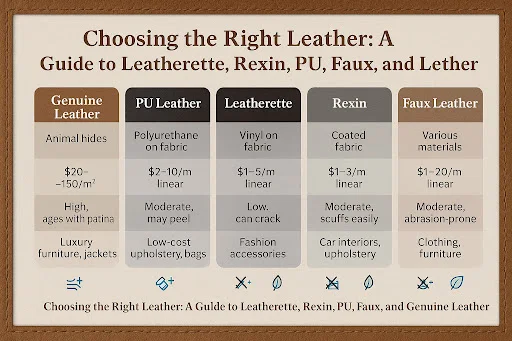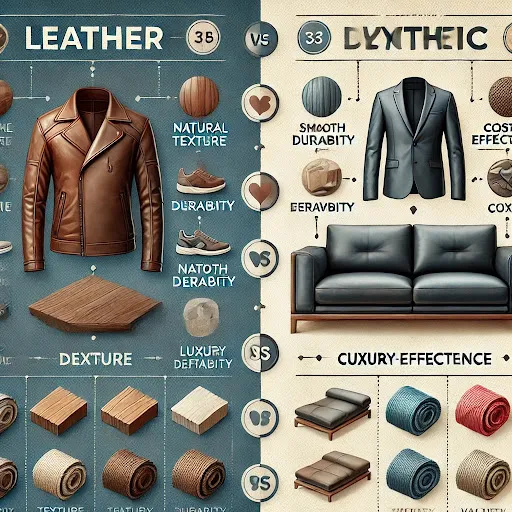- Genuine leather is made from animalides, offering durability and a natural look, but it’s costly and requires maintenance, with ethical concerns due to animal sourcing.
- Faux leather is a broad term for synthetic alternatives, including PU leather and leatherette, which are vegan-friendly and cheaper but less breathable, with varying environmental impacts.
- PU leather, made with polyurethane, being durable and closely mimicking genuine leather, while leatherette is often PVC-based, less durable, and more plastic-like.
- Rexin, historically a brand, now refers to affordable synthetic leather, typically PVC-based, used in upholstery and car interiors, with lower durability compared to PU leather.
- Market prices vary: genuine leather ($20–$150/m²), PU leather ($2–$10/m linear), leatherette ($1–$5/m linear), Rexin ($1–$3/m linear), depending on quality and region.
Comprehensive Analysis of Leatherette, Rexin, PU, Faux Leather, and Genuine leather is derived from animal hides, primarily cowhide, processed through tanning to enhance durability and usability. It is categorized into full-grain (highest quality, retaining the natural grain), top-grain, and split-grain, with full-grain being the most durable and expensive. Research suggests that genuine leather offers a natural texture, unique grain patterns, and an earthy scent, developing a patina over time that enhances its aesthetic appeal. It’s made from collagen-based animal skins, ensuring natural breathability.Market prices for genuine leather are typically quoted per square meter, as it’s sold by area due to the varying sizes of hides. From sources like BuyLeatherOnline and Leatherite, prices range from €20 to €140 per square meter for standard to exotic types, which, at an exchange rate of approximately €1 = $1.10, translates to $22 to $154 per square meter. More commonly, standard types range from $20 to $150 per square meter, as seen in listings from Buckskin Leather Company and IndiaMart, where prices per square foot (converted to per square meter) align with this range.Prominent manufacturers include Horween Leather Co., Buckskin Leather Company, and Tandy Leather, known for high-quality hides used in upholstery, apparel, and accessories. For example, Horween Leather Co. offers a range of full-grain and top-grain leathers, while Buckskin Leather Company provides detailed pricing lists.
- For durability and a natural look: Opt for genuine leather, ideal for long-term investments, but be prepared for higher costs and maintenance.
- For affordability and animal-friendly options: Faux leather, particularly PU leather, offers durability and versatility, suitable for high-traffic areas like office furniture.
- For budget-conscious projects: Leatherette or Rexin may suffice, though they are less durable and more plastic-like, best for short-term or low-wear applications.





